Taxila
Q156093Taxila (Old Indian Takshaçila, Greek Ταξίλα): the ancient capital of the eastern Punjab, the country between the rivers Indus and Hydaspes. The site consists of several parts, which belong to the Achaemenid, Greek, and Kushan periods.
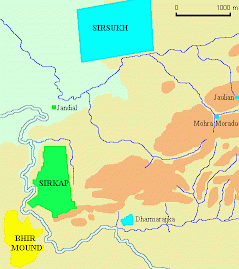
That Taxila was very famous, can be deduced from the fact that it is mentioned in several languages: in Sanskrit, the city was called Takshaçila, which may be interpreted as "prince of the serpent tribe"; in Pâli it was known as Takkasilâ; the Greeks knew the town as Taxila (Ταξίλα), which the Romans rendered as Taxilla; the Chinese called it Chu Ch'a-shi-lo. The ruins are some 30 kilometers northwest of modern Islamabad.
The town commanded the Indian "royal road" (Uttarāpatha), which connected Gandara (the valley of the river Cophen, modern Kabul) in the west to the kingdom of Magadha in the Ganges valley in the east. Another important route was the Indus river from Kashmir in the north to the Indian Ocean in the south. To fully understand the importance of Taxila, it must be noted that the Khunjerab pass between Kashmir and Xinjiang (the current Karakoram highway) could already be crossed in Antiquity; therefore, Taxila was also connected to the Silk road between Babylonia in the far west and China in the far east.
Early History
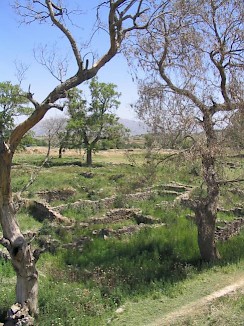
Taxila was founded in the seventh or sixth century BCE, according to legend by a son of the brother of the legendary hero Rama. The first town was situated on a hill that commanded the river Tamra Nala, a tributary of the Indus. It was an important cultural center and it is said that the Mahabharata was first recited at Taxila. This site is currently called Bhir. The residential area was in the east; the western part of the town seems to have had a ceremonial function. If the "Pillared hall" was indeed a sanctuary, as is maintained by several archaeologists, it is the oldest known Hindu shrine.
Taxila was the capital of a kingdom that was called Hinduš (or Indus-country) and consisted of the western half of the Punjab. It was added to the Achaemenid empire under king Darius I the Great, but the Persian occupation did not last long. There are no archaeological traces of the presence of western armies in the Punjab, although in 2002, archaeologists have claimed to have found a Persian building.note
When the Macedonian conqueror Alexander the Great occupied Gandara and the Punjab in 326, the Indian kingdoms had already regained their independence. King Ambhi of Taxila, who is called Taxiles ("the man from Taxila") and Omphis in the Greek sources, had invited Alexander in 329, because he needed support against king Porus (Indian: Puru) of Pauravas, a state that was situated in the eastern Punjab. Alexander did what he had been asked to do: he defeated Porus on the banks of the river Hydaspes (modern Jhelum). However, he unexpectedly allied himself to Porus, and forced Ambhi and Porus to reconcile themselves. Leaving the region, he left behind an occupation force of Macedonian and Greek veterans under a satrap named Philip. When this man was murdered in 325, Alexander sent a Thracian named Eudamus to share the reign with Ambhi.
Mauryas
Alexander died on 11 June 323, in far-away Babylon. Immediately, the veterans in the eastern satrapies decided to fight themselves a way back to Greece. They were defeated by an army commanded by Peithon, the newly appointed satrap of Media. For the time being, all remained quiet in the east, but many Europeans had died, and the grip of the survivors on the eastern periphery, which had never been very firm, became very weak indeed. In 316, king Chandragupta of the Mauryan dynasty of Magadha (321-297) could conquer the Indus valley. Taxila lost its independence and became a provincial capital.
Chandragupta was succeeded by Bindusara. His son Ashoka was governor of Taxila until 269, when he succeeded his father. Ashoka became famous for his religious policy: he stimulated Buddhism wherever possible. At Taxila, the existing monastery, which was situated on the other bank of the river, was abandoned. Two new monasteries were built to the east. The Dharmarajika monastery, where Ashoka buried several relics of Buddha, is still famous for its stupa.
Indo-Greeks
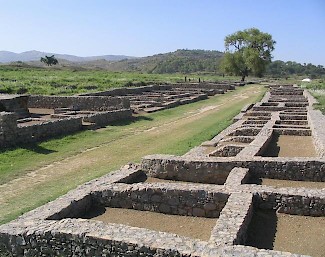
In 184, the Greeks, who had maintained a kingdom in Bactria, invaded Gandara and the Punjab again. From now on, there was a Greek king living in Taxila. His name was Demetrius. The town was rebuilt on the plains on the other bank. This second Taxila, now called the Sirkap ("severed head"), was built according to the Hippodamian Plan, that is: according to Greek fashion, like a gridiron. The largest sanctuary, now called "apsidal temple", measured 70x40 meters. The Sun temple and a sanctuary known as "shrine of the double-headed eagles" are near the apsidal temple.
Demetrius' kingdom consisted of Gandara, Arachosia, the Punjab and a part of the Ganges valley. It was a multi-ethnic society, in which Greeks, Bactrians, western Iranians and Indians lived together. Greek religious practices, Iranian cults, Hinduism, Jainism, and Buddhism are all known from second-century Taxila. For example, there was a Zoroastrian sanctuary at Jandial, directly north of Sirkap, while the city itself boasted all kinds of sanctuaries.
Sacae
After 110 BCE, the Punjab was gradually taken over by the Sacae. This is a common name for the nomad tribes of Central Asia, who always tried to invade the territories to their south, such as Bactria. They had been kept away since the age of king Cyrus the Great, but had ravaged the Graeco-Bactrian kingdom in c.130 and had finally settled in Drangiana, which was henceforth called Sacastane or Sistan. At the beginning of the first century BCE, they launched raids on Gandara and infiltrated in the southern Indus valley and settled in Taxila.
Parthians
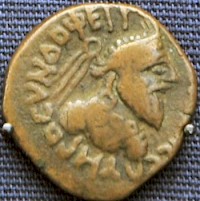
In the second half of the first century BCE, the Parthians became interested in the region and started to take over the Greek petty kingdoms of Gandara and the Punjab. One of the Parthian leaders, living in Taxila, was named Gondophares. According to an old and wide-spread Christian tradition, he was baptized by the apostle Thomas. Although the story is impossible - Gondophares was king before Jesus was born - it documents that adherents of several religions lived together in Gandara and the Punjab. There may indeed have been an audience for a representative of a new Jewish sect, even when Gondophares died before Thomas was born.
Another visitor was a Greek philosopher named Apollonius of Tyana. A description of Taxila can be found in the Life of Apollonius of Tyana by the Greek author Philostratus. In section 2.20 he writes that the town is as big as Nineveh and was fortified like the Greek cities.
While Apollonius was engaged in this conversation, messengers and an interpreter presented themselves from the king, to say that the king would make him his guest for three days, because the laws did not allow of strangers residing in the city for a longer time; and accordingly they conducted him into the palace. I have already described the way in which the city is walled, but they say that it was divided up into narrow streets in the same irregular manner as in Athens, and that the houses were built in such a way that if you look at them from outside they had only one storey, while if you went into one of them, you at once found subterranean chambers extending as far below the level of the earth as did the chambers above.note
Kushans
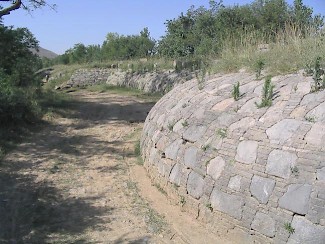
In ca. 80 CE, the Yuezhi nomads or Kushans took over the area. Again, Taxila was refounded, this time even further to the north. This third town is known as Sirsukh. It must have looked like a large military base. The wall is 5 kilometers long and no less than 6 meters thick. From now on, Taxila was visited by Buddhist pilgrims from countries as far as Central Asia and China. There were many sanctuaries and monasteries in the neighborhood, like Jaulian and Mohra Moradu.
The city was badly damaged when the Huns invaded the Punjab in the fifth century, and never recovered.
Literature
- John Marshall, A guide to Taxila (19603)